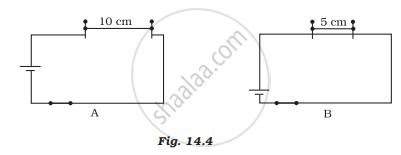Advertisements
Advertisements
प्रश्न
Why does the cord of an electric heater not glow while the heating element does?
उत्तर
The heating element of the heater is made up of alloy which has very high resistance so when current flows through the heating element, it becomes too hot and glows red. But the resistance of cord which is usually of copper or aluminium is very low so it does not glow.
APPEARS IN
संबंधित प्रश्न
An electric iron of resistance 20 Ω takes a current of 5 A. Calculate the heat developed in 30 s.
When current is switched ‘on’ in a room heater, it ______.
An electric room heater draws a current of 2.4 A from the 120 V supply line. What current will this room heater draw when connected to 240 V supply line?
What is meant by the heating effect of current? Give two applications of the heating effect of current.
Name the material which is used for making the filaments of an electric bulb.
Which of the following characteristic is not suitable for a fuse wire?
(a) thin and short
(b) thick and short
(c) low melting point
(d) higher resistance than rest of wiring
Give Scientific reason
In the electric equipment producing heat e.g. iron, electric heater, boiler, toaster etc, an alloy such as Nichrome is used, not pure metals.
Solve the following question.
Compute the heat generated while transferring 96000 coulombs of charge in two hours through a potential difference of 40 V.
Which of the following substance contracts on heating?
Find the odd one out and give its explanation.
Why is parallel arrangement used in domestic wiring?
Your teacher has shown you the following activity.

Activity: The teacher has wound a long insulated piece of wire around an iron nail in the form of a coil. The free ends of the wire are connected to a cell through a switch as shown in Figure 14.3. The current is switched on and some pins are placed near the ends of the nail.
Write down any three questions that come to your mind about this activity
Paheli took a wire of length of 10 cm. Boojho took a wire of 5 cm of the same material and thickness. Both of them connected the wires as shown in the circuit given in Figure 14.4. The current flowing in both circuits is the same.
(i) Will the heat produced in both cases be equal? Explain
(ii) Will the heat produced be the same if the wires taken by them are of equal lengths but of different thicknesses? Explain.

What are the uses of electromagnets?
It would cost a man Rs. 3.50 to buy 1.0 kW h of electrical energy from the Main Electricity Board. His generator has a maximum power of 2.0 kW. The generator produces energy at this maximum power for 3 hours. Calculate how much it would cost to buy the same amount of energy from the Main Electricity Board.
Fuse is a strip of alloy wire which is made up of lead and tin with a very low ______.
Name a few appliances which work on the basis of the heating effect of current.
An electric kettle consumes 1 kW of electric power when operated at 220 V. A fuse wire of what rating must be used for it?
State the law that explains the heating effect of current with respect to the measurable properties in an electrical circuit.
